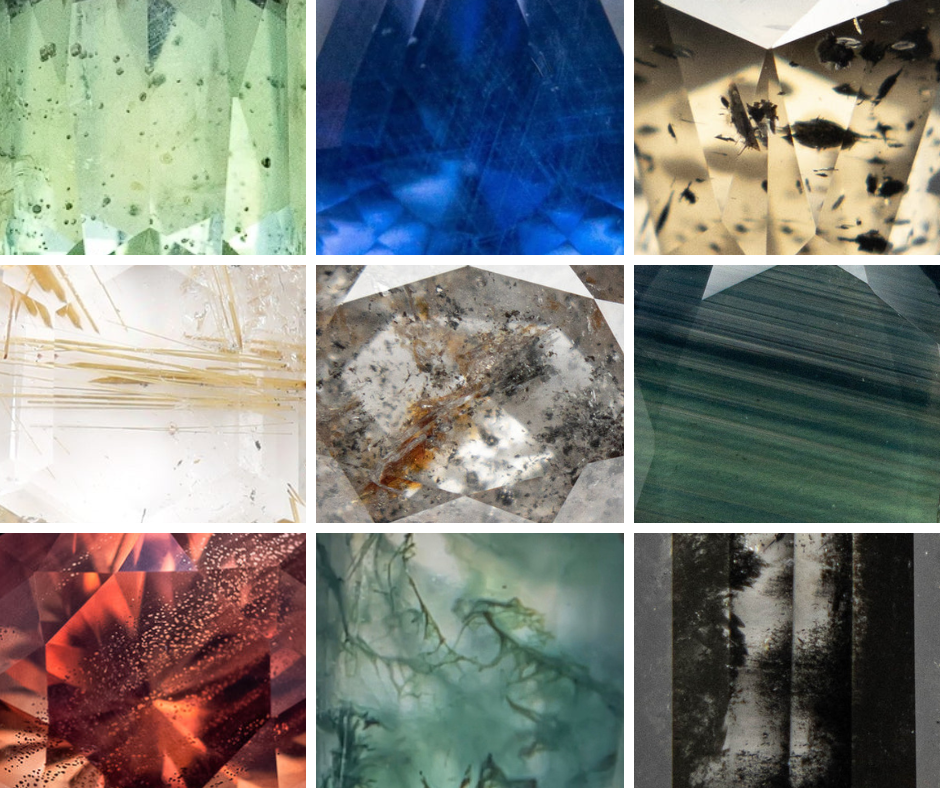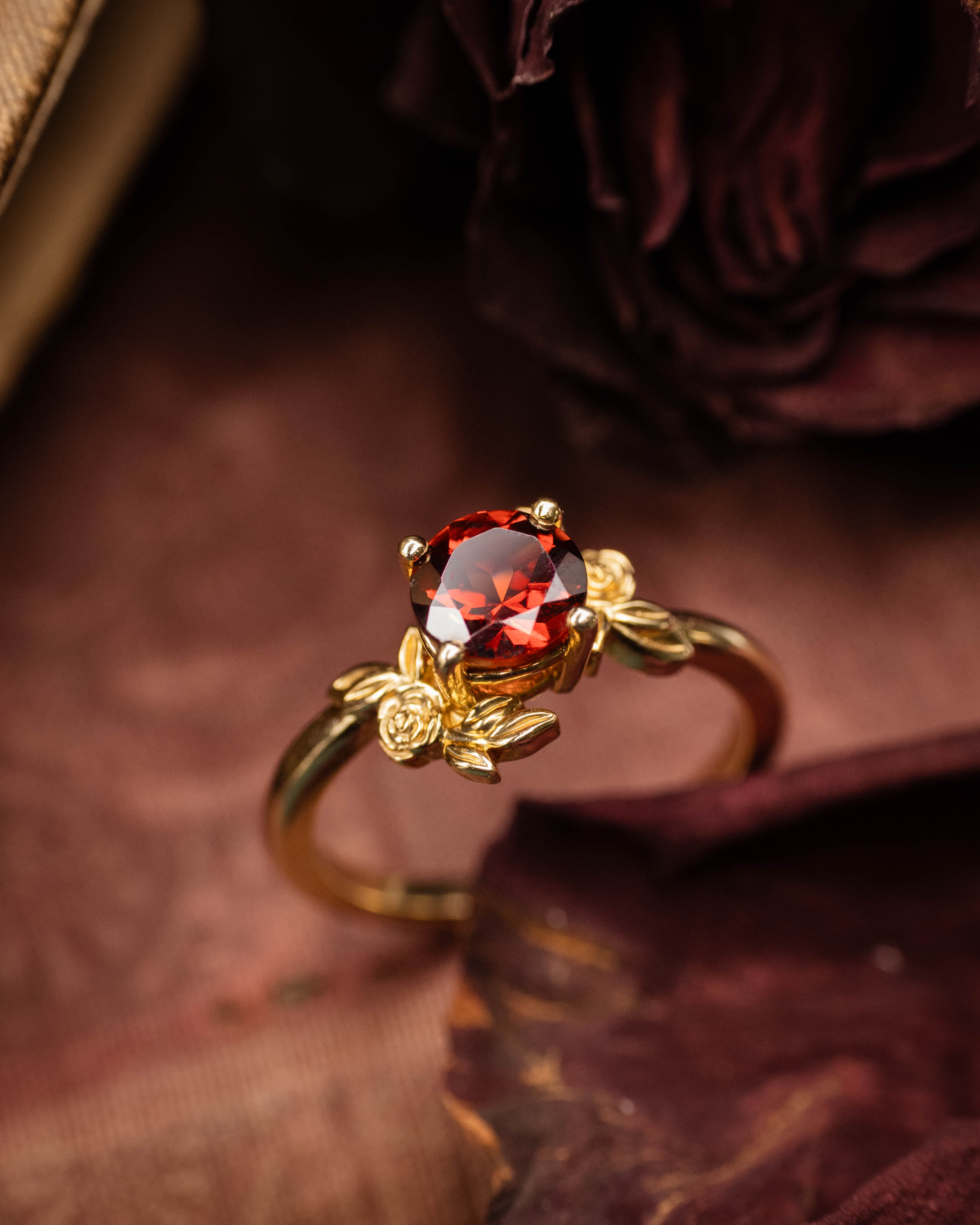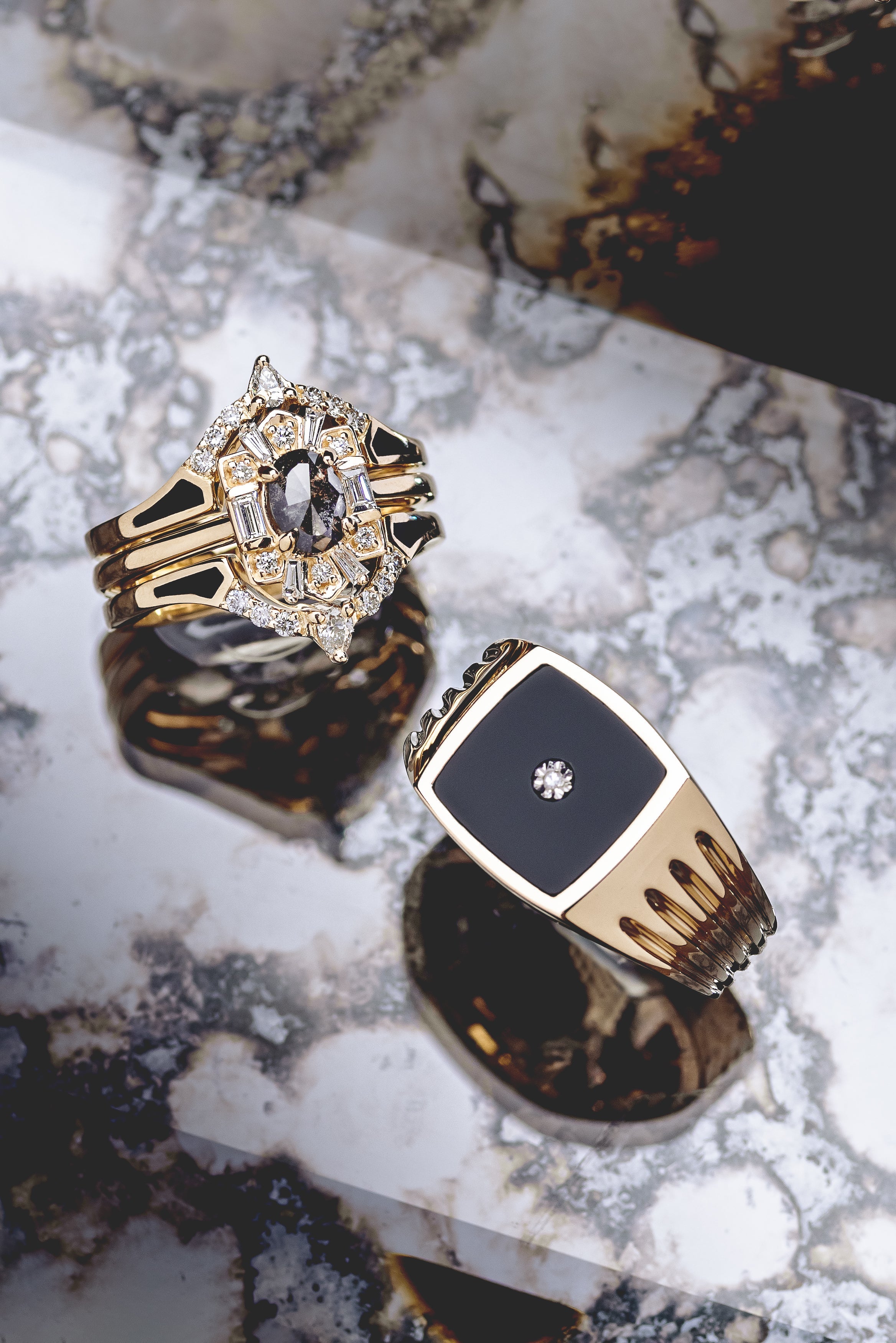
Signatures of Nature - Gemstone Inclusions
Like snowflakes or fingerprints, no two natural gemstones will ever be the exact same. This is especially evident in stones with inclusions. Take, for example, salt and pepper diamonds. The color and characteristics of each stone vary wildly based on the amount and types of inclusions present within each stone.

Inclusions are a natural consequence of crystal growth and are shared among natural stones and sometimes even lab-created stones. While some people do not like stones with inclusions, others appreciate the natural and rustic look that inclusions give a stone! All types of natural crystals or minerals can have inclusions. Still, we will focus mainly on corundum (sapphires and rubies) and diamonds while mentioning a few other notable included gems in this blog.
Salt and Pepper Diamonds
Salt and pepper diamonds are diamonds that contain many inclusions giving them a speckled appearance - like they have been seasoned with salt and pepper. Salt and pepper diamonds are the misfits of the diamond world. In the past, their presence of inclusions made them undesirable outcasts in the jewelry world, and jewelers typically refused to work with them at all. The mindset was (and still is for some) that only clear diamonds with minimal inclusions will do. However, very clear diamonds are quite rare, and a lot of earth must be mined in order to find stones like this. Unfortunately, this way of mining produces a lot of waste and is very hard on the environment. In addition, traditional diamonds are much more expensive, currently starting around $5,000-$10,000 for a high-quality stone. On the other hand, salt and pepper diamonds are much more common and require a lot less damaging mining to acquire. Because they are a common by-product of traditional diamond mining and because their inclusions make them less valuable in the fine jewelry industry. They are much more affordable than traditional diamonds, typically around $1,000-$2,000 for a one-carat stone. Creative jewelers and designers have recognized the beauty in their unique colors and characteristics, catering to customers who desire a ring and stone that better represent their personality and relationship!
There are many types of inclusions and flaws that can be present in diamonds including but not limited to:
- Graining
- Bearding
- Clouding
- Feathering
- Cracks and inclusions
- Chips
- Pinpoints
- Wisps
- Other crystals growing inside the gem

As shown above, the appearance of salt and pepper diamonds varies widely - from almost black to milky white and mostly clear to mostly included. These inclusions are typically elements like graphite and hematite that were present during the formation of the stone. The orange inclusions in the oval cut salt and pepper diamond in the center of the collage above come from nitrogen and are referred to as "goldfish" inclusions for their similarity in appearance to... you guessed it: Goldfish! Truly, these diamonds allow the imagination to run wild, creating pictures of galaxies in a night sky, fog in a forest of trees, or raindrops on a window on a gray stormy day.
Even traditional clear diamonds have inclusions. Sometimes these are visible to the naked eye, and other times a jeweler's loupe is needed to see them. It is simply a consequence of nature, and the way crystals grow - it is the prominent presence and appearance of inclusions in a diamond that determine whether a stone is a salt and pepper diamond or not. Diamonds are typically graded based on the four C's - clarity, cut, color, and carat. However, the GIA or any diamond grading organizations are not currently grading salt and pepper diamonds on the traditional diamond grading scale but rather classifying them as a "fancy" variety of diamonds. The four C's do not apply to salt and pepper diamonds, and there are not currently any other grading systems for these stones.
Certain inclusions like cracks and feathering can make a stone more prone to breaking from hard impacts. This risk is something to keep in mind when picking out a specific salt and pepper diamond. One with a lot of feathering or cracking may be best in a bezel or other protective settings. This is not a concern with salt and pepper diamonds, and many are just as durable as traditional diamonds. As with any gemstone, including traditional diamonds, special care should always be taken to avoid causing damage and maintain the longevity of the stone.
Even though salt and pepper diamonds have had a bad rap for a long time, they are increasing in popularity among jewelers and customers alike. The uniqueness of each stone and relative affordability compared to traditional diamonds makes them an excellent choice for anyone looking for a ring with a special touch! We love working with these stones and embracing their natural beauty!
Our "Rhea" design 14K white gold engagement ring with a beautiful pear rose cut salt and pepper diamond center stone.

Corundum (Sapphires and Rubies)
Sapphires and rubies are made up of hard corundum crystals. As corundum crystals grow, inclusions of gas, minerals, & liquids can become trapped within the stone. These inclusions can appear in a variety of ways including:
- Cavities
- Feathers
- Halo/discoid fractures
- Crystals within the host crystal
- Silk/rutile
- Vapor or liquid droplets, etc.
This 1.70ct pear-shaped unheated blue sapphire from Sri Lanka from the Staghead Mine X Misfit Gems showcases beautiful rutile silk inclusions within the stone. The "silk" are the lines running through the stone. These can sometimes lead to an asterism effect like what's seen in cat's eye stones or "star sapphires." These silk inclusions can actually increase the value of the stone!

Inclusions in corundum can also appear as color-zoning or color-banding, which is a lack of uniformity of color throughout the stone. Color-zoning can be completely random and organic throughout the stone or color-banding can appear as angular lines within the stone. Color uniformity within sapphires is considered more valuable in the jewelry industry than sapphires with color-zoning or banding, however, for someone looking for a more unique look these sapphires are a great option! Not only are they usually more cost effective, but sapphires with color-zoning and other unique visual elements are a popular trend right now!
This 3.08ct portrait cut sapphire from Australia is an excellent example of color-banding in the form of lines with varying layers of green, blue, and brown.

Sometimes inclusions can have an appearance similar to bubbles. This is especially the case with crystal inclusions: other crystals trapped within the host crystal (in this case corundum). Unfortunately, fake or imitation "gemstones" made of glass often have similar-looking bubble inclusions, which can make determining whether a gemstone is real or fake more difficult (especially just by the naked eye). For example, let's look at a glass marble:

Bubbles are visibly trapped within the glass. When glass is melted, chemical reactions occur that cause gas to be released. Sometimes this gas becomes trapped within the glass and becomes a residual consequence of this process. Now compare these bubbles to the inclusions seen in a stone like this Montana Sapphire:

There are small specks of what looks like bubbles throughout the stone. However, this is more likely small crystal inclusions within the stone. To the untrained eye, it may be difficult to tell the difference; Luckily, there are three easy ways to determine real from fake corundum gems!
- A jeweler or gemologist can usually tell the difference between glass, heated sapphires, and unheated sapphires by examination under a loupe or microscope.
- Even easier is to use a diamond tester. A diamond tester can distinguish hard minerals like diamond and sapphire from softer minerals like glass (which usually won't even register on the device).
- Of course, most people don't have a diamond tester sitting around, but most people do have the supplies to conduct a simple scratch test. Corundum ranks nine out if ten on the Mohs Hardness Scale and is very difficult to scratch. In fact, the only minerals hard enough to scratch sapphire would be ruby (which is also corundum), moissanite, and diamond. Glass typically ranks around 5.5, so it will be scratched by any mineral harder than that on the Mohs scale. A steel nail or file should be able to scratch a fake glass stone, but it should not be able to scratch a true corundum stone. This method can be destructive if the stone is fake, so caution should always be used before conducting a scratch test.
Another way to avoid fake stones is to always purchase stones from reputable businesses and dealers.
Inclusions can also sometimes help us determine if a gemstone has been heat treated or not. Heat treatment of stones causes some inclusions to dissolve and disappear, improving clarity. This is especially common with sapphires. This is a widely accepted treatment in the jewelry industry and does not harm the value of sapphires. However, because this treatment often improves the clarity of the stone, natural unheated sapphires are very scarce. At Staghead Designs we work with both heated and unheated stones.
Other Notable Stones With Inclusions
There are many other stones that have inclusions, and the quartz family of stones is certainly no exception! Rutilated quartz is clear quartz that contains mineral rutile needles included in the stone. Golden rutile needles like the ones seen in the stone below are typically hematite or copper. There are other similar quartz varieties with different types of inclusions such as tourmalinated quartz (inclusions of tourmaline) or strawberry quartz (with pink/red hematite inclusions).
This golden rutilated quartz showcases beautiful rutile needles running throughout the stone.

Moss agate is a variety of chalcedony, which is a type of quartz. Moss agate contains green inclusions that resemble the appearance of moss - hence the name. The green inclusions are not actually moss, but rather chlorite dendritic-style inclusions.
Dendritic quartz is another quartz stone with inclusions similar in appearance to moss agate. The inclusions in this case are typically iron, manganese, hematite, etc. and create a tree-like or fern-like appearance within the stone.
Stones that are members of the feldspar family including rainbow moonstone, labradorite, and sunstone exhibit an effect called aventurescence or "schiller". In labradorite and rainbow moonstone this appears as a blue sheen, while it is typically a copper luster in sunstone. Schiller is usually caused by copper or hematite inclusions.
https://www.youtube.com/embed/jYBzfXwqCsA
Conclusion
The inclusions within each type of stone mentioned above will vary in appearance between each stone. Both of the engagement rings below feature hexagon moss agate center stones, but the stones have quite different appearances. The stone in "Octavia" on the left has more of a clear/milky white field with just a bit of green inclusions whereas the stone in "Artemis" on the right features more inclusions, making the stone appear more green. This variety is something to keep in mind when choosing a ring with any included center stone as we cannot control the exact appearance the stone will have and it will vary some from the pictures in the listing. This is the exciting part about included stones - each one will be uniquely different!

In the end, it is up to you to choose a stone that best suits your needs and preferences. Whether you prefer highly included stones or more clear stones, we are happy to offer both as options to be used in our custom ring designs! We offer a variety of stone types, colors, and prices with options to fit nearly any budget and preference! Start with your stone by visiting the Staghead Mine and working with our talented designers to create a one-of-a-kind ring, or browse our collections of available customizable designs today!



